

 Server authentication
Server authenticationWhen you define a secure connection, Host On-Demand offers three options on the Security tab: Enable Security, Security Protocol, and Send a Certificate (client authentication).
Click Enable Security to enable server and client authentication.
Security Protocol specifies the method used for client and server authentication. Select one of the following options:
SSL by itself does not guarantee that the client is communicating with the correct server. To illustrate the risks involved with this protocol, consider the following scenario. There are two servers, Server1 (hod.S1.com) and Server2 (hod.S2.com), and one client, Client. Both servers have valid certificates from a CA that the client trusts. Client wants a secure session with Server1, but Server2 wants to eavesdrop on their communication, and is physically located in such a place that it can do so. The scenario goes as follows:
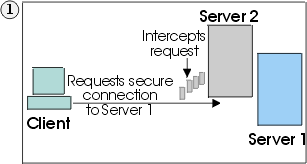 |
Client sends a request for an SSL session to Server1. The request (and all subsequent traffic) actually goes through Server2. Instead of forwarding Client's request to Server1, Server2 responds directly to the request by sending its own certificate to Client. |
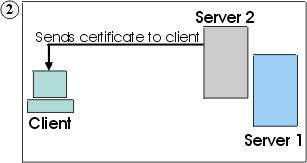 |
Client receives Server2's certificate and checks its list of trusted CAs. Since Server2's certificate is signed by the same CA as Server1's certificate, Client accepts the certificate and creates a secure session with Server2. |
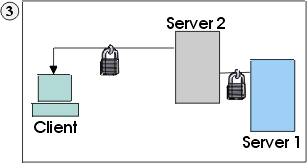 |
Having completed the secure session with Client, Server2 requests and creates its own SSL session with Server1. From this point, Client sends encrypted information to Server2. Server2 decrypts the information, re-encrypts it, then sends it to Server1. It does the same for information flowing in the opposite direction. The result is that, although all data is encrypted when it flows over the Internet, Server2 is able to read it, and even change it. |
To help avoid this danger, the Server Authentication (SSL) option is provided. When this is switched on, the client, after making sure that the server's certificate can be trusted, checks whether the Internet name in the certificate matches the Internet name of the server. If they match, the SSL negotiation will continue. If not, the connection ends immediately.
For this check to be valid and give a positive result, two conditions must be met:
With Server Authentication (SSL) enabled, the security scenario would proceed as follows:
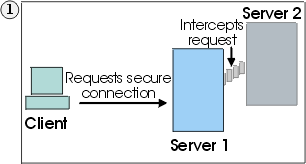 |
1. Client sends a request for an SSL session to Server1. The request (and all subsequent traffic) actually goes through Server2. Instead of forwarding Client's request to Server1, Server2 responds directly to Client's request by sending its own certificate to Client. |
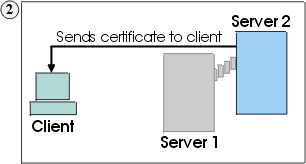 |
2. Client receives Server2's certificate and checks its list of trusted CAs. Since Server2's certificate is signed by the same CA as Server1's certificate, Client accepts the certificate and creates a secure session with Server2. |
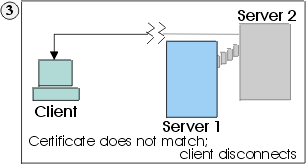 |
3. After the secure session has been completed, but before any real data has been sent or received, Client compares the Internet name in the certificate it received (hod.S2.com) with the name of the server it wants to talk to (hod.S1.com). Since they do not match, Client knows that the connection should not continue and disconnects it. |